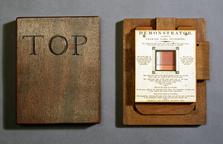

Wheel of Theodorus mathematical quilt
- Made:
- 1998 in West Lafayette






Wheel of Theodorous mathematical quilt, inspired by the Greek mathematican's use of the root spiral to explain irrational numbers, made by Elaine Krajenke Ellison, 1998.
The introductory object representing beauty is appropriately based on Greek mathematics, as the Greeks were especially interested in harmony and order in nature. Theodorus, who was mentioned by Plato, studied the square roots of numbers up to 17, finding that many of them ‘had no common measure’, a concept already familiar to Indian mathematicians. He is thought to have represented these numbers in a ‘wheel’ or spiral. The bright yellow triangles have sides in the ratio 1:1:2. The adjacent triangles have sides 1:2:3; the next have sides 1:3:4 (= 2), etc. The quilt was made by hand.
Details
- Category:
- Mathematics
- Object Number:
- 2000-1087
- Measurements:
-
overall (estimate): 3 x 780 x 410 mm
- type:
- quilt (mathematical)
- credit:
- Ellison, Elaine Krajenke



